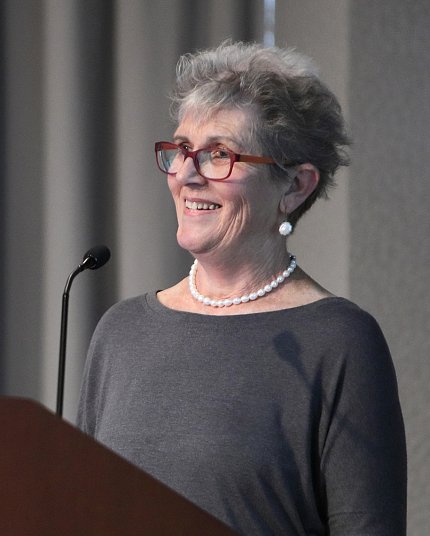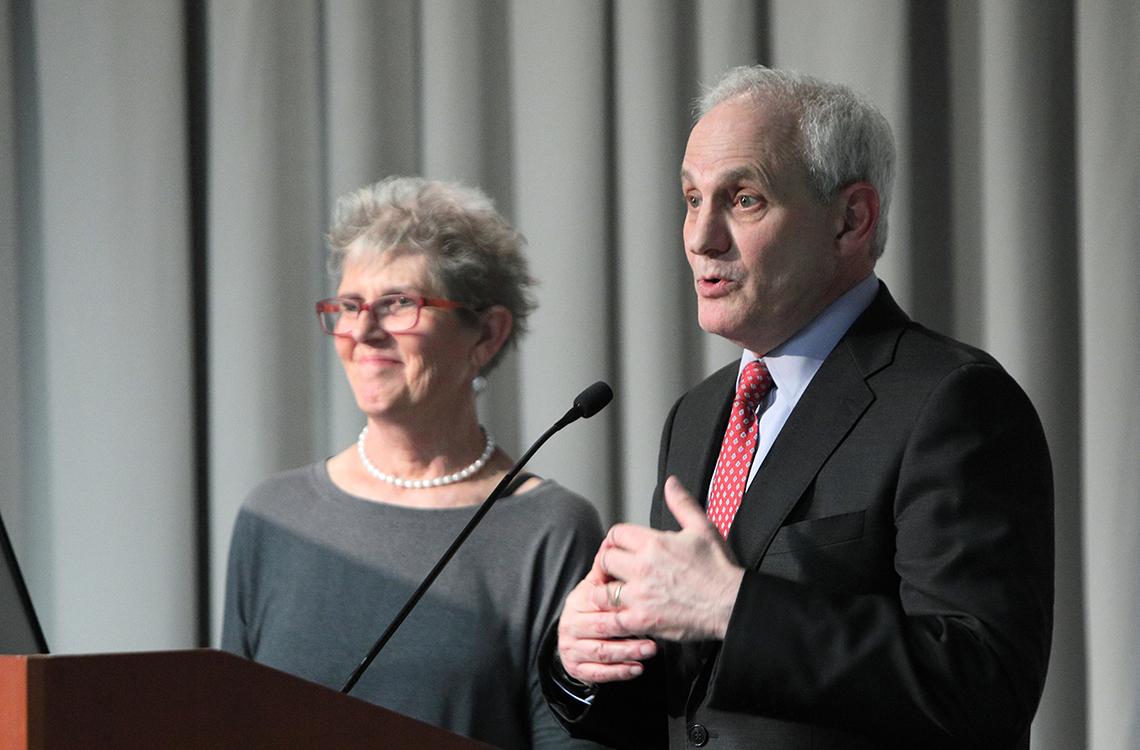Immunotherapy Benefits NIH Scientist/Author

Photo: Chia-Chi Charlie Chang
One morning in January 2015, Dr. Barbara Lipska sat down at her desk and went to turn on her computer. Her hand disappeared. She couldn’t see anything in her right visual field. The terrifying experience was like a freaky magic trick.
“The first thought that entered my mind was...brain tumor,” said Lipska, director of NIMH’s Human Brain Collection Core and author of The Neuroscientist Who Lost Her Mind: My Tale of Madness and Recovery, at a recent NIMH Director’s Innovation Speaker Series lecture at the Neuroscience Center.
The vision problems persisted through the morning. The next day she was diagnosed with three brain tumors. Shortly after, she underwent radiation and neurosurgery to remove the biggest one, which was bleeding and blocking her vision. She had been previously diagnosed with melanoma and had the skin tumor resected. Melanoma, however, commonly spreads to other parts of the body, including the brain.
Lipska searched for alternative therapies because she was certain the tumors would come back. After consulting with her family and many doctors about her options, she enrolled in an immunotherapy clinical study led by Dr. Michael Atkins, deputy director of the Lombardi Comprehensive Cancer Center at Georgetown University Medical Center.
For most of his career, Atkins said, melanoma was known as “the cancer that gives cancer a bad name.” Its incidence was increasing and there were few effective treatments for it until 2011. That year, researchers found that 45 percent of melanomas had a mutation in a gene called BRAF.

Photo: Chia-Chi Charlie Chang
The gene provides instructions to a protein responsible for cell growth and division. This discovery led to the development of therapies targeting the mutation. Scientists also learned more about how cancer cells interfere with the immune system’s ability to attack the cells.
The study Lipska enrolled in evaluated the effectiveness of a combination of two immunotherapy drugs. Atkins said the drugs “acted on different parts of the immune response.” Previous studies had suggested a combination produced dramatically better results.
Lipska started immunotherapy in April 2015. “Everything was going well. I was physically fit, emotionally strong and otherwise healthy. It seemed that I would have no problems. I had some rashes and other little things—but they were nothing compared to the very real possibility that I would die,” she said.
About a month later, her behavior changed. She irritated easily, yelled more and got lost in her neighborhood. At first, her family attributed her behavior to the stress of undergoing cancer treatment. She became convinced everyone was trying to hurt her. One day, she tried to fire her exterminator for spraying pesticides.
Her daughter emailed Atkins after Lipska falsely claimed she was poisoned by a pizza slice that was stuffed with plastic. Atkins ordered more testing immediately. A brain scan found more than 20 tumors in her brain—15 of them new.
“This was not a good situation. We had never seen this before,” Atkins said. Doctors began to think about alternatives. She was prescribed a steroid to decrease inflammation and targeted therapy designed for BRAF mutation.
Despite the circumstances, Lipska didn’t worry at all. “I didn’t have insight or awareness of the situation,” she explained. “I was the one spared of worry.”
A few weeks later, Lipska underwent another scan. Atkins saw there were significantly fewer lesions and the ones that remained had shrunk. Lipska also rapidly regained her sanity.
“I remember the facts, but to this day, I don’t remember any emotions associated with these events,” she said.
Lipska stopped taking all therapy in June 2016. Since then, Atkins has been monitoring her in case the melanoma recurs. Another 20 patients who received treatment have ended therapy and 18 are in remission. One patient died of a different cancer and another was treated successfully with surgical resection of a recurrence. In the Georgetown Lombardi series, 80 percent of those with metastatic melanoma who received the combination immunotherapy are cancer-free after 3 years.
“This treatment accomplished what patients want, which is the treatment ends and the benefit persists. We call that treatment-free survival,” Atkins said. “And Dr. Lipska is actually the poster child for treatment-free survival.”
Before her diagnosis, Lipska was an avid marathoner and triathlete. Once her treatment ended, she’s been able to get back in shape. In June, she competed in a triathlon with her daughter.
“We’re striving to make cancer a curable disease. With these new treatment options—and Dr. Lipska is living evidence—I think that’s possible,” concluded Atkins.

Photo: Chia-Chi Charlie Chang
